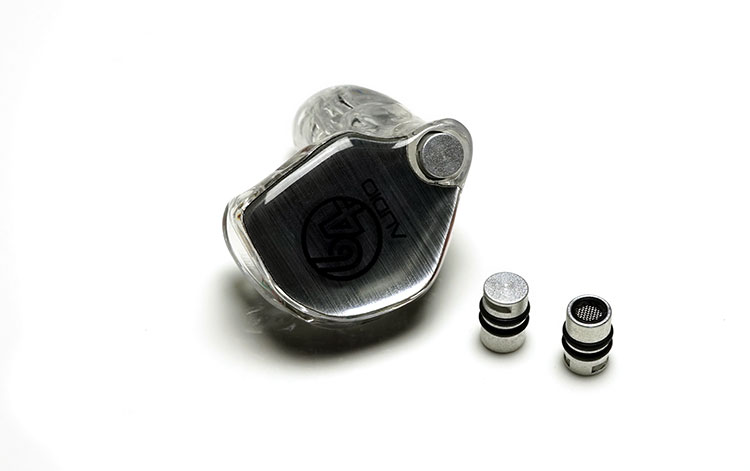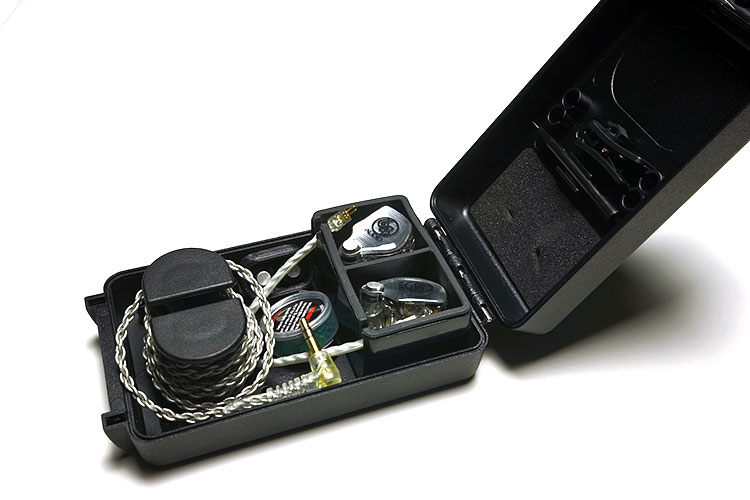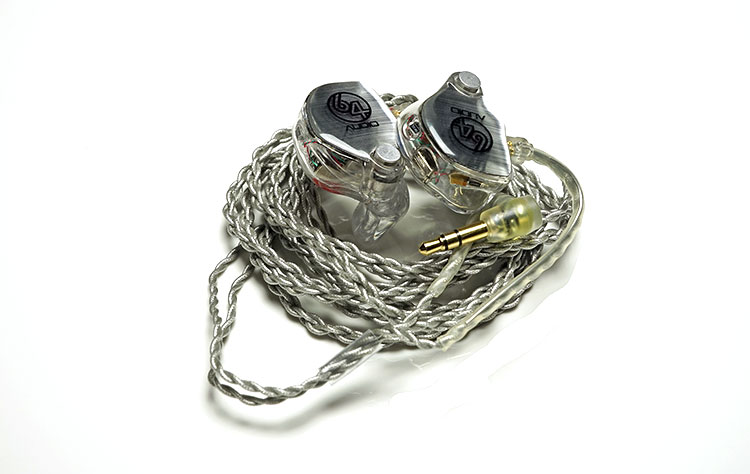Meet The 64 Audio A6
Shell & Design
The 64 Audio A6 came out exactly as I imagined it would look from the online designer tool. Craftsmanship is top-notch without a bubble, scratch, or inconsistency in sight.
Given that this is a clear translucent shell you have the added curiosity of being able to see the entire inner workings of the BA design. It looks very neat and very well laid out with very few tangles and clean wiring all the way.
The faceplate is behind a well-polished and deep acrylic covering but much like the A12 materials, it’s very transparent, with plenty of pop.
There are no blemishes on the brush strokes of the faceplate either. This is a very smooth plate that gives off a much colder precision-type glow than the organic colors of brown and koa wood on the A12. It’s a lovely contrast between the pair.
The logo is on the polished acrylic surface rather than on the faceplate itself and given the depth of the faceplate, the logo has a type of 3D shimmery effect that is a nice if unintended, effect when viewing the entire piece at different angles.
The tri-bore finished shell is as smooth as a baby’s butt, I kid you not. The 3D process may have color limitations but it is no slouch when it comes to producing a smooth finish on the entire shell. The level of polish is not overly cooked either. It looks precise and is a mirror reflection of my original ear impression.
The Port & Modules
The port placement for the APEX modules had not changed from the original ADEL-designed A12. The port acts as a pneumatically interactive vent that allows the air pressure in a sealed ear canal to escape using the APEX technology and leaving just the sound pressure going into your ear.
It is relatively easy to pull out or slide back in from the rest of the shell should you have both the M15 and the M20 and wish to swap around.
The modules themselves come in a tiny cup holder of sorts with each sold as a pair. I would advise keeping them close to hand or in the carry case as they are small and thus liable to get lost easily if not carefully handled.
Though tiny they feel very solid in the hand with good build quality. The top of the filter is flush metal with its ports just below in the slight indent. There are two rubber rings to help ease the module in and out of its socket on the shell without cosmetic damage through unwanted friction and at the bottom, there is a metal mesh filter.
You can differentiate between the M20 and M15 modules through their coloring scheme with the M15 having a darker gunmetal-type coating and the M20 having a brighter silver finish.
Comfort & Isolation
Credit to the Ear Guy
It helps to find a good consistent audiologist to take your ear impressions because once 64 Audio gets them they now scan them digitally for use on future purchases.
Since the A12 had an excellent fit and seal it was super-efficient to just ask the team to reuse my digital impression scans. That saves a lot of cash sending out new impressions and ensures you get a consistent build each time.
Isolation
The 64 Audio A6 is exactly like the A12 in that respect given they are carved out of the same digital scan. It is a “pro” fit which to me is a deep insertion rather than a wide but short nozzle which I term as a “relaxed” fitting.
If you are slightly uncomfortable with long nozzle designs though you can request a shorter nozzle. However, for me personally, I prefer the long nozzle design as it feels more secure when inserted. This would be typical of a musician or studio-type design request where there will be lots of movement that could dislodge the seal.
The seal and passive noise isolation are bang on 100% and no joke. The passive isolation on this is world-class (M20 module inserted) with nothing getting through, not an iota of air-con noise, wind, and general humdrum. Event noise will be heard but that’s normal.
What I mean by event noise is single higher-pitched noise such as dogs barking, doors slamming, etc. which is normal.
Short Comparison
In comparison to other leading designs out there, the 64 Audio A6 fit and seal are on par with the A12 (same design), superior to the Rhines Stage 5 and Stage 7 as well as my old Merlins, deeper than Vision Ears single wide-bore designs and maybe just as deep as the SA-43 from M-Fidelity.
Comfort levels are just slightly behind Custom Art’s wonderful silicone design on the 8.2 but ahead of Minerva’s Mi-Pro by some distance.
Accessories & Packaging
Now this is one area that 64 Audio has revamped since 2015 and largely for the better. Previously, the gear would arrive in a plastic bag with a slip-on sleeve over a Pelican case and that was about it.
It was solid but a little boutique in appeal. Now your gear comes with a thin but long retail box and a bespoke hard case that’s about half the size of the original Pelican case. It looks a lot more professional now and feels a lot more complete.
Hard Case
The hard case is as customizable as ever on the outside with logos, names whatever you want just on a slightly smaller scale. In comparison to the Pelican case, it wins points for mobility and size but I think it may lose points in durability and lack of weather sealing. This is only due to Pelican cases being incredibly good at sealing.
The new in-house case seems strong enough but it doesn’t have that little rubberized cornering between the lid and bottom that keeps out the moisture. 64 Audio has handily thrown in a silica case for everyday moisture build-up should you need it but I wouldn’t throw this one in a puddle with confidence.
Inside
The inside of the case is very different from the older case. Gone are the contoured cutaway foam sections of the old pelican case and in place, you have very specific functional areas.
At the base, you have a pillar for wrapping the cable, and at the top a small rubberized dual box container for the driver units. In between, you have space for the silica gel and anything else that fits.
Underneath the lid is something akin to one of those small nail treatment kits with everything sensibly laid out in their distinct areas and latches including the cleaning tool, shirt clip, and inserts for up to 4 modules with a small rubber pad that sits over the shells protecting them from knocks and bumps.
I like it. It’s purposeful, well laid out, and makes use of just about every area of the case. The only caveat I have is the time it takes to put everything back in its place, most particularly the cable, it a bit of a slow process compared to the older case.
Sound Impressions
Stock Cable/M20 Module
Tonally the 64 Audio A6 is a complete break from the old V6 when using the stock cable. In their page notes, 64 Audio describes the A6 as warm but transparent sounding. That I agree with, it is quite warm in that respect, and with the stock cable perhaps a shade too warm with an ever-present soft but thick note.
If you are expecting the ethereal treble greatness of yonder years, then the 64 Audio A6 is not that. No sir, the A6 has gone south and opted for a slightly more consumer-friendly thicker sound with an emphasis on a sub-bass rumble and a more prominent midrange performance.
This is a signature more at home with musicality and with rock as well as some aspects of EDM than any erring preference for down-the-line neutrality.
Stock Cable/M15 Module
Switching out the M20 to the dual ambient port M15 module still retains that smooth personality but pulls back a little on the bass weight and body and gives a little more of a mid-centric focus and a slightly better balance than the M20.
Those who prefer a bit more low-end heft should stay with the M20 but those who want a little more space around their vocals a touch more air and a more natural attenuation beyond 7k will enjoy the M15 tonal tweak and presentation.
If anything, my preference is the M15 with its better-performing treble response and more balanced low to midrange performance.
Bass
The bass on the 64 Audio A6 is full-sounding, and weighted but not overly dominant. It does though possess decent extension and exhibits that BA healthy turn of pace but with a slightly longer than average decay adding to that sheen of warmth sub 250Hz.
Sub-bass presence sub 100Hz is slightly more elevated with a decent rumble and instead of elevating the mid-bass it slowly drops to around 500Hz and remains steady throughout the midrange before dipping again around 3-4k.
With the M15 module, the sub-bass elevation drops down by 4dB at 20Hz so you get a more linear and tactile response than the more full-blooded M20 performance.
Mids
The midrange itself, though relatively balanced, could do with a bit more bite, the dynamics are just okay and the vocals sound natural but they possess a softness much in keeping with the rest of the midrange.
The switch between the M15 or M20 won’t give too much additional bite, both are relatively smooth sounding but the M15’s more linear bass response will give a bit more perceptible space for the mids to sound more open than the M20.
Vocals can be a little source and module-dependent for me which can be good and bad. The best-performing stock cable pairing with the X7/AM3 had a slightly elevated clear and natural-sounding vocal performance whereas the Paw Gold gave a woolier interpretation that tended to throw a veil over the vocal performance, particularly for male vocals.
With the M15 module though I got a slightly cleaner and more spacious sounding vocal performance on the X7/AM3 combo as well as the AK240.
Female vocals tended to perform better on the 64 Audio A6, particularly on sparse ambient tracks and where the vocal has a slightly higher pitch. Neither male nor female vocals exhibit sibilant traits which are a big bonus.
Treble
Treble has been dialed back a touch also with the stock cable, giving it a more relaxed and sibilant-free presentation but less airy sounding as a result.
The detail is there, though, it is not overly smoothed out but does exhibit coloration, downplaying percussion presence, and upper treble sparkle in favor of a non-fatiguing smoother presentation.
If you want to jack up the air a little and introduce a touch more sparkle in the final octave then the M15 module is superior to the M20 in that respect.
Cable Swapping
Stock Cable
The stock cable that comes with the 64 Audio A6 is the classic CIEM copper-infused braided cable that comes with a lot of custom monitors.
It can come in either 48″ or 64″ lengths and is terminated with 2-pin connectors and a gold-plated 3.5mm right-angle jack. It is soft, pliant, easy to work with, light, and microphonic-free. It is a decent cable but not a game-changer.
Tonality
Now normally I work the cable into the first page of the review but this time it is a key component of my sound impressions because it is a warm-sounding cable that bottlenecks a lot of the A6 potential.
I am typically cable agnostic but in this case, changing the cable will bring positive changes to the sound of the A6 that I think are worth noting and I would highly recommend you grab one if you can.
Options
The good news for those emitting a small groan is that you do not need to whack out $500 plus for a top-performing cable to get something different. ALO Audio Deals’ $149 SXC24, which is an SPC cable is an excellent “reasonably priced” cable to consider for musicality.
However, if you do want to get a good reference cable then the $323 Twag V4 Litz Silver from Whiplash is fantastic to work with on the A6. By the way, these are not subtle differences from the stock cable. It is night and day and very easy to pick out the three cables’ signatures with the A6.
ALO Audio SXC24
($149 on ALO Deals)
Tonally the A6 is much closer to neutral now and that slight veil on the vocal performance is blown away. This is a clean, snappy, and very detailed performance and is vastly superior to the stock cable in every way. It still has a slight sub-bass bias with plenty of rumble but it is much tighter now and better defined with a spacious sound. This cable is a good musical choice.
The same with the mids. I would have classified that warm stock sound as being a little too warm for my tastes. The SXC24 still keeps that meaty midrange sound but brings in a much higher level of clarity and more of an edge in its timbre.
Treble extension is marginally better but the real payoff is that enhanced level of clarity, cleaner attack, and a better sense of articulation. It is still a relaxed treble lilt but it is not overly smoothed over.
Whiplash TWag V4 Litz Silver
The V4 also brings a more neutral balanced tonal presentation to the A6 compared to the stock cable but it trades some of that slightly forward sparkle of the SXC24 for a more natural and balanced tone.
This is more of a reference sound than the SXC24. The bass is coherent, never overpowering but man it hits deep and fast when it needs to, mids are neutral with vocals, though not quite as forward as the SXC24, and sounds a little more natural. Treble attack and decay are very naturally balanced with zero sibilance, decent articulation, and airier sounding than stock.
I give the slight edge to the SXC24 in terms of engagement, musicality, and top-end sparkle but the Twag is the most accurate sounding and balanced of the two cables. Also, the microphonics on the Twag is lower than the SXC24.
Click on Page 3 below for recommended pairings & Comparisons





